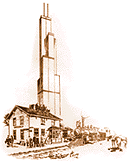|
Sears Expansion
Gradually, a comprehensive code of retail operating
techniques was worked out, enabling store managers to
concentrate on two essentials - selling and proper
ordering. The new techniques were as vital to retail as
the time-schedule system was to mail order.
Another milestone was passed in 1932 when Sears
established the store planning and display department.
Before merchandise had been fitted into buildings, now
buildings were built around merchandise. The first store
to be built from the inside out was the Glendale,
California store opened in 1935. The new store planning
and display department concerned itself with all
elements of the store - tables, fixtures, space
requirements for the different merchandise lines,
customer flow and width of aisles. The store shell was
built around the selling floor plan.
When Sears opened its Pico Boulevard store in Los
Angeles four years later, a rival merchandising
executive paid tribute: "In my long experience in
the retail field," he said, "I have yet to
witness a retail unit which equals Sears Pico Store in
practical efficiency, merchandise engineering,
operation, layout and presentation of merchandise."
Another important approach to urban customers was
made through catalog sales desks, which were installed
in the retail stores. In another move, Sears opened
catalog sales offices in towns too small to support
retail stores. Two decades later, the company launched
an additional catalog operation - the independent
catalog merchant program - in which a person operates
his or her own store to sell Sears merchandise.
 In
1942, the company opened its first store in Havana,
Cuba, its first permanent retail outlet in a foreign
land. But due to shortages created by World War II,
refrigerators, stoves, washing machines, fans - all the
hardlines so familiar in Sears stores - soon disappeared
from the new Havana store. In 1947, with war shortages
disappearing, Sears opened a store in Mexico City. In
subsequent years, Sears opened stores or sales offices
in Central and South America and Europe. In the early
1980s, Sears divested itself of many of its foreign
retail operations. In
1942, the company opened its first store in Havana,
Cuba, its first permanent retail outlet in a foreign
land. But due to shortages created by World War II,
refrigerators, stoves, washing machines, fans - all the
hardlines so familiar in Sears stores - soon disappeared
from the new Havana store. In 1947, with war shortages
disappearing, Sears opened a store in Mexico City. In
subsequent years, Sears opened stores or sales offices
in Central and South America and Europe. In the early
1980s, Sears divested itself of many of its foreign
retail operations.
Sears expansion south of the border was matched in
1953 by its expansion north of the border. Sears joined
a pioneer Canadian merchandising company, Simpsons,
Limited to form Simpsons-Sears Limited. The Canadian
subsidiary now is known as Sears Canada Inc.
In 1969, Sears announced plans to build a new
headquarters building in downtown Chicago. The 110-story
Sears Tower became the world's tallest building at 1,454
feet when it was opened in 1973. The staggering amount
of materials needed to construct the building included
76,000 tons of steel, 2 million cubic feet of concrete,
16,000 tinted windows, 1,500 miles of electrical wiring
and 80 miles of elevator cable.
|


 In
1942, the company opened its first store in Havana,
Cuba, its first permanent retail outlet in a foreign
land. But due to shortages created by World War II,
refrigerators, stoves, washing machines, fans - all the
hardlines so familiar in Sears stores - soon disappeared
from the new Havana store. In 1947, with war shortages
disappearing, Sears opened a store in Mexico City. In
subsequent years, Sears opened stores or sales offices
in Central and South America and Europe. In the early
1980s, Sears divested itself of many of its foreign
retail operations.
In
1942, the company opened its first store in Havana,
Cuba, its first permanent retail outlet in a foreign
land. But due to shortages created by World War II,
refrigerators, stoves, washing machines, fans - all the
hardlines so familiar in Sears stores - soon disappeared
from the new Havana store. In 1947, with war shortages
disappearing, Sears opened a store in Mexico City. In
subsequent years, Sears opened stores or sales offices
in Central and South America and Europe. In the early
1980s, Sears divested itself of many of its foreign
retail operations.